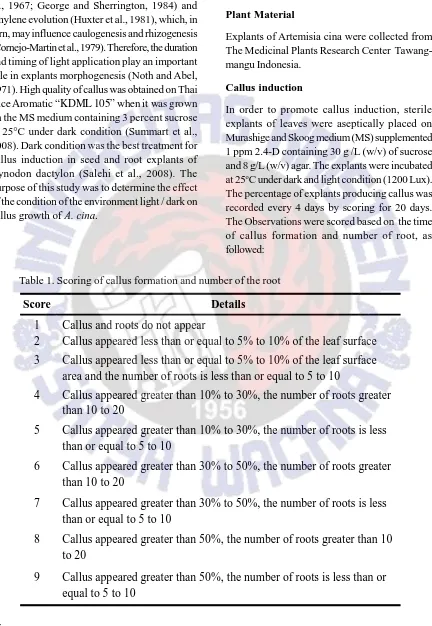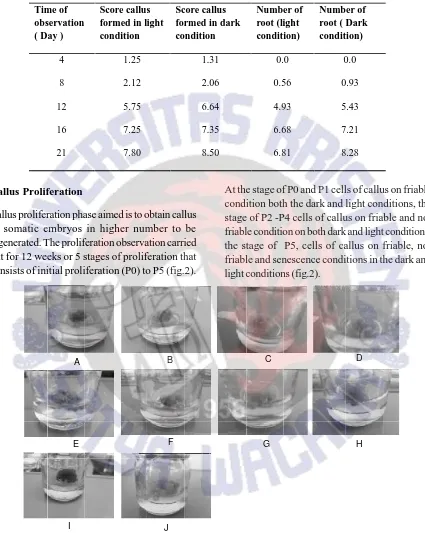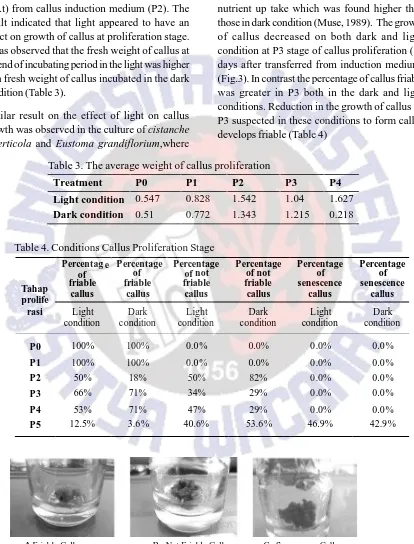CALLUS INDUCTION AND PROLIFERATION OF ARTEMISIA CINA BERG
EX POLJAKOV
INDUKSI KALUS DAN PROLIFERASI ARTEMISIA CINA BERG
EX POLJAKOV
Maria Marina Herawati
1, Aziz Purwantoro
2, Endang Sulistyaningsih
2, Suwijiyo Pramono
3Masuk 14 Maret 2014, diterima 28 Mei 2014
1Graduate Student, Faculty of Agriculture, Gadjah Mada University, Indonesia. email: [email protected] 2Faculty of Agriculture, Gadjah Mada University, Indonesia
3Faculty of Pharmacy, Gadjah Mada University, Indonesia
ABSTRAK
Penelitian ini bertujuan untuk mengevaluasi efek kondisi terang dan gelap pada induksi dan proliferasi kalus dari kalus Artemisia cina. Eksplan steril akan dikulturkan pada media MS dengan kandungan 2.4-D 1 mg/L dan diletakkan pada kondisi terang dan gelap. Hasil penelitian menunjukkan bahwa induksi kalus akan lebih efektif pada kondisi gelap, sedangkan proliferasi kalus lebih efektif pada kondisi terang. Tahap terbaik untuk proses regenerasi adalah hari ke-48 setelah transfer dari media induksi.
Kata kunci: kondisi gelap, kondisi terang, proliferasi kalus, induksi kalus, Artemisia cina
Introduction
Herbs and natural ingredients are generally not a new thing since those are needed for drugs in order to solve the health problems. Plants and microbes are the main source of secondary metabolites (Hayashi et al.,1997; Armaka et al.,1999; Lin et al.,1999; Baso et al., 2005), and to be the main source of new drugs (Harvey, 2000), both such as phenol compounds, alkaloids, terpenoids, as well as non-protein amino acids (Smith,1976). Artemisia cina included in the genus Artemisia (Asteraceae) is one of the plants that can be used as a medicinal plant.The phytopharmacological evaluation of aerial parts of this genus showed the presence of anti-inflammatory (Ahmad et al., 1992), antibacterial (Kristiani et al., 2009; Kristiani et al., 2010; Kovats
et al., 2010), anthelmintic (Tariq et al., 2009) and antimalarial activities (Cubukcu et al., 1990).
to influence the rates of cell division (Fraser et al., 1967; George and Sherrington, 1984) and ethylene evolution (Huxter et al., 1981), which, in turn, may influence caulogenesis and rhizogenesis (Cornejo-Martin et al., 1979). Therefore, the duration and timing of light application play an important role in explants morphogenesis (Noth and Abel, 1971). High quality of callus was obtained on Thai Rice Aromatic “KDML 105” when it was grown on the MS medium containing 3 percent sucrose at 25°C under dark condition (Summart et al., 2008). Dark condition was the best treatment for callus induction in seed and root explants of Cynodon dactylon (Salehi et al., 2008). The purpose of this study was to determine the effect of the condition of the environment light / dark on callus growth of A. cina.
Table 1. Scoring of callus formation and number of the root
Score
Details
1
Callus and roots do not appear
2
Callus appeared less than or equal to 5% to 10% of the leaf surface
3
Callus appeared less than or equal to 5% to 10% of the leaf surface
area and the number of roots is less than or equal to 5 to 10
4
Callus appeared greater than 10% to 30%, the number of roots greater
than 10 to 20
5
Callus appeared greater than 10% to 30%, the number of roots is less
than or equal to 5 to 10
6
Callus appeared greater than 30% to 50%, the number of roots greater
than 10 to 20
7
Callus appeared greater than 30% to 50%, the number of roots is less
than or equal to 5 to 10
8
Callus appeared greater than 50%, the number of roots greater than 10
to 20
9
Callus appeared greater than 50%, the number of roots is less than or
equal to 5 to 10
MATERIAL AND METHOD
Plant Material
Explants of Artemisia cina were collected from The Medicinal Plants Research Center Tawang-mangu Indonesia.
Callus induction
Callus Proliferation
The callus formed from induction were weighing and transferred to a MS medium supplemented 1 mg/L 2.4-D containing 30 g /L (w/v) of sucrose and 8 g/L (w/v) agar. The explants were incubated at 25oC under dark and light condition (1200 lux). Callus growth was observed for 12 weeks. Sub-cultures were conducted every 16 days. In every sub culture the callus were weighted and observed to classify into three classes namely: callus friable, callus not friable and callus senescence.
RESULT AND DISCUSSION
Callus Induction of Artemisia cina
In order to establish the most suitable condition for callus induction we placed the explant under dark and light condition. Callusing was initiated on the
A B C
C D E
F G I
Fig.1. A. Initial callus induction material; B. The 8 days-old callus after induction in light conditions; C. The 8 days-old callus after induction in dark conditions; D. the 12 days-old callus in light conditions; E. The 12 days-old callus in dark conditions; F. The 16 days-old callus in dark conditions; G. The 16 days-old callus in light conditions; H. The 20 days-old callus after callus induction in dark conditions; I. The 20 days-old callus after induction in light conditions.
eighth days after induction both in the dark and light condition. The phenomenon that occurs in callus induction of A. cina is that root emergence on the surface of leaves and callus appears at the bottom of the leaf (Fig.1).
Table 2. Scoring Callus Formed and The Number of Roots In Dark/ Light Conditions
Time of observation ( Day )
Score callus formed in light condition
Score callus formed in dark condition
Number of root (light condition)
Number of root ( Dark condition)
4 1.25 1.31 0.0 0.0
8 2.12 2.06 0.56 0.93
12 5.75 6.64 4.93 5.43
16 7.25 7.35 6.68 7.21
21 7.80 8.50 6.81 8.28
Callus Proliferation
Callus proliferation phase aimed is to obtain callus of somatic embryos in higher number to be regenerated. The proliferation observation carried out for 12 weeks or 5 stages of proliferation that consists of initial proliferation (P0) to P5 (fig.2).
At the stage of P0 and P1 cells of callus on friable condition both the dark and light conditions, the stage of P2 -P4 cells of callus on friable and not friable condition on both dark and light conditions, the stage of P5, cells of callus on friable, not friable and senescence conditions in the dark and light conditions (fig.2).
Fig. 2. A. Early proliferation (P0) dark conditions, 16 days after transferred; B. Early proliferation (P0) light conditions, 16 days after transferred; C. Proliferation 1 (P1) dark conditions, 32 days after transferred; D. Proliferation 1 (P1) light conditions, 32 days after transferred; E. Proliferation 2 (P2) dark conditions, 48 days after transferred; F. Proliferation 2 (P2) light c onditions, 48 days after transferred; G. Proliferation 3 (P3) dark conditions, 64 days after transferred; H. Proliferation 3 (P3) light conditions, 64 days after transferred; I. Proliferation 4 (P4) under dark conditions, 80 days after transferred; J. Proliferation 4 (P4) under light conditions, 80 days after transferred.
A B C
H D
E
J
G
I
In The other hand observations of proliferation could be used to determine the exact age of callus to regeneration. The best stage to regenerate from proliferation callus was 48 days after transferred (d.a.t) from callus induction medium (P2). The result indicated that light appeared to have an effect on growth of callus at proliferation stage. It was observed that the fresh weight of callus at the end of incubating period in the light was higher than fresh weight of callus incubated in the dark condition (Table 3).
Similar result on the effect of light on callus growth was observed in the culture of cistanche deserticola and Eustoma grandiflorium,where
the presence of light was found to increase the production of callus (Ouyong et al., 2003; Mousavi et al., 2012). The increase of callus growth in the light condition might be related to the rate of nutrient up take which was found higher than those in dark condition (Muse, 1989). The growth of callus decreased on both dark and light condition at P3 stage of callus proliferation (64 days after transferred from induction medium) (Fig.3). In contrast the percentage of callus friable was greater in P3 both in the dark and light conditions. Reduction in the growth of callus on P3 suspected in these conditions to form callus develops friable (Table 4)
A.Friable Callus B. Not Friable Callus C. Senescence Callus Fig.3. Callus Condition
Table 4. Conditions Callus Proliferation Stage
Tahap
Treatment P0 P1 P2 P3 P4
Light condition 0.547 0.828 1.542 1.04 1.627
Dark condition 0.51 0.772 1.343 1.215 0.218
Conclusion
Research conducted showed that callus induction more affected by the dark condition while callus proliferation more affected by light condition. The best stage to regenerate is 48 days after transferred from induction medium.
Knowledgment
Thanks to the Center for Medicinal Plant Research Tawangmangu for Artemisia cina Berg ex Poljakov.
REFERENCE
Ahmad F, Khan RA, Rasheed S.1992. Study of analgesic and anti-Inflammatory activity from plant extracts of Lactuca scariola and Artemisia Absinthium. J. Islam. Acad. Sci., 5(2): 111-114.
Armaka, M., E. Papanikolaou, A. Sivropoulou. 1999. Antiviral properties of isoborneol, a potent inhibitor of herpes simplex virus type 1. Antiviral Research 43: 79-92.
Basso, L.A., L.H. da Silva, A.G. Fett-Neto, W.F. de Azevedo Jr., I.S. de Moreira, M.S. Palma, J.B. Calixto, S. Astolfi-Filho, R.R. dos Santos, M.B. Soares, and D.S. Santos. 2005. The use of biodiversity as source of new chemical entities against defined molecular targets for treatment of malaria, tuberculosis, and T-cell mediated diseases; A Review. Memio Instituto do Oswaldo da Cruz 100: 475-506.
Cornejo-Martin, M.J., A.M. Mingo-Castel, and E. Primo-Millo. 1979. Organ redifferentiation in rice callus: Effects of C2H4,CO2, and cytokinins.Z. Pflanzenphysiol. 94:117-123.
Cubukcu B, Bray DH, Warhurst DC, Mericli AH, Ozhatay N, Sariyar G. 1990. In vitro antimalarial activity of crude extracts and compounds from Artemisia abrotanum L. Phytother. Res., 4(5): 203-204.
Fraser, R.S., U.E. Loening, and M.M. Yeoman. 1967. Effect of light on cell division in plant tissue cultures. Nature (London) 215:873.
George EF, Sherrington PD. 1984. Plant propagation by tissue culture. Exegetics LTD, Westbury.
Hangarter, R. P. and Stasinopoulos, T. C. Repression of plant tissue culture growth by light is caused by photochemical change in the culture medium. Plant Sci, 79(2) 253-257. 1991.
Harvey, A. 2000. Strategies for discovering drugs from previously unexplored natural products. Drug Discovery Today 5 (7): 294-300.
Hayashi, K., T. Hayashi, H. Otsuka, (dkk.) 1997. Antiviral activity of 5,6,7-trimethoxyflavone and its potentiation of the antiherpes activity of acyclovir. Journal of Antimicrobial Chemotherapy 39, 821-4.
Khanna, H.K. and S.K. Raina, 1998. Genotype x Culture Medium Interaction Effects onRegeneration Response of Three Indica Rice Cultivars. Plant Cell Tissue and Organ Culture, 52: 145-153.
Kovats N, Goloncser F, Acs A, Refaey M. 2010. Quantification of the antibacterial properties of Artemisia absinthium, Artemisia vulgaris, Chrysanthemum leucanthemum and Achillea millefolium using the Vibrio fischeri bacterial bioassay. Act. Bot. Hungar, 52(1): 137-144.
Kristianti.E.B.E dan Herawati.M.M. 2009.Uji Antibakteri dari Artemisia cina.UKSW, Salatiga.
***
Lin, Y.M., M.T. Flavin, R. Schure, D.E. Zembower,and G.-X. Zhao. 1999. Biflavanoids and derivatives there of as antiviral agents. United States Patent 5948918. September 7, 1999.
Mousavi.E.S, Behbahani.M, Hadavi.E, Miri.S.M. 2012. Callus induction and plant rege-neration in Lisianthus (Eustoma grandi-florium). Trakia Journal of Sciencies, Vol.10.No.1. 2012.
Muse, R. 1989. Physiology and Biochemistry of Witches Broom Disease in coca (Theolorona cocoal.) ph.D Thesis. Univ. of Liverpool, England, U.K.
Noth, M.H. and W.O. Abel. 1971. Zur entwicklung haploider pflanzen aus unreifen mikros-poren verschiedener Nicotiana arten. Z Pflanzenszucht. 65:277-284.
Ouyong, J., Wang, X. Zhoo, B and Wang Y. 2003. Light intensity and spectral quality influencing the callus growth of Cistanene deserticola and biosynthesis of phenyle-thanoid glycosides. Plant Science, 165:39 653-661.
Salehi. H. Salehi. M and Ashiri.F. 2008. Some condition for the best callus induction in Common Bernudagrass (Cynodon dactylon (L) Pers. California Origin. American-Eurasian J.Agric and Environ. Sci.3 (3):409-413.
Shirin F, Hossain M, Kabir MF, Roy M, Sarker SR. 2007. Callus inducation and plant regeneration from intermodal and leaf explants of four potato cultivars. World J. Agric. Sci. 3:1-6.
Smith, P.M. 1976. The Chemotaxonomy of Plants. London: Edward Arnold.
Summart. J, Panichajakul. S, Prathepa. P and Thanonkeo. P. 2008. Callus induction and influence of culture condition and culture medium on growth of Thai Aromatic Rice, Khao Dawk Mali 105, cell culture. World applied Science Journal 5 (2):246-251.
Tariq KA, Chishti MZ, Ahmad F, Shawl AS. 2009. Anthelmintic activity of extracts of Artemisia absinthium against ovine nematodes. Vet. Parasitol, 160: 83-88.


